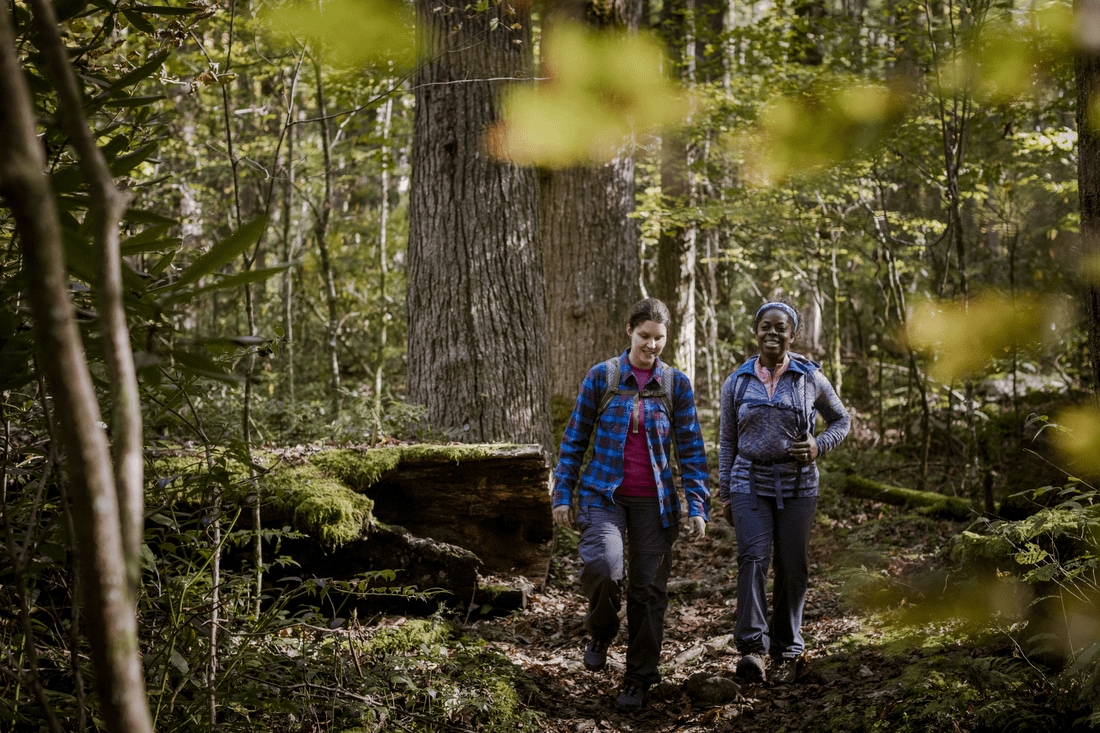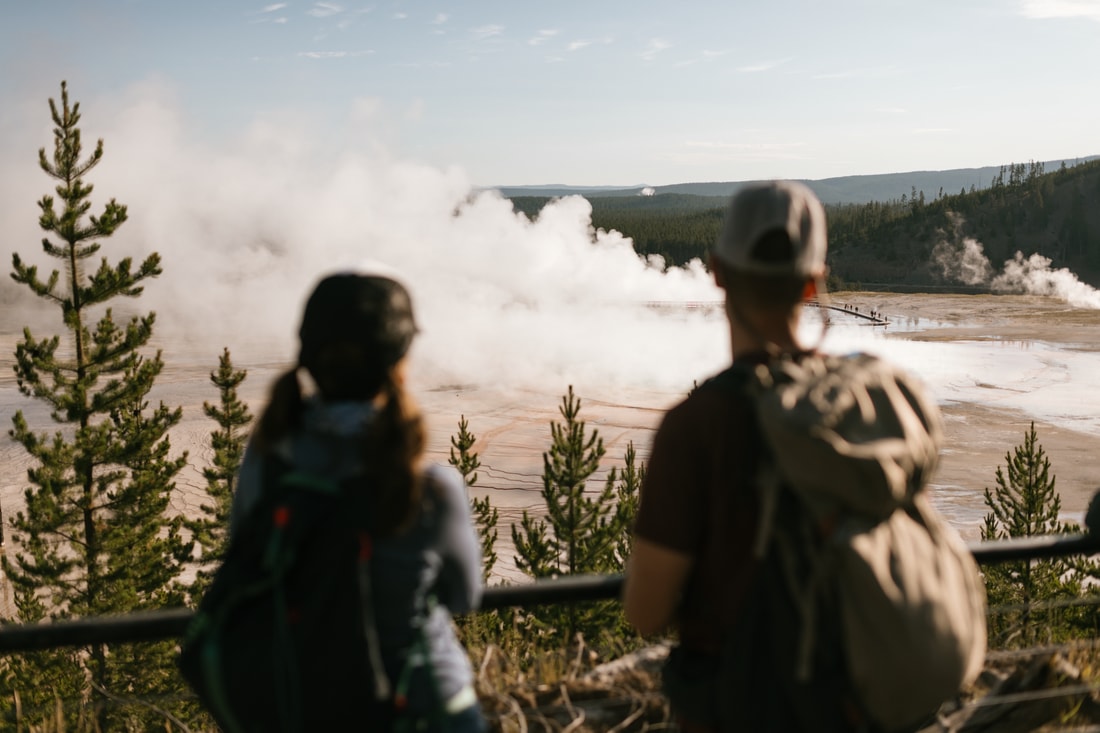There’s nothing like looking out at a spectacular sunset from a ridgeline or leaving your worries behind as you trek through a thicket of trees. Many of our most special moments are experienced outside. But what’s better than enjoying them with someone else? Whether you’re a novice hiker or an alpine climber, a hiking companion can transform your adventures: They can amuse you, share their skill sets and cheer you on when the going gets tough.
Here are our top tips and tricks for a seamless trek with a trailmate.
Hike with Someone You Like
Hiking is one of the best ways to reconnect with a significant other, deepen a bond with a friend, establish new relationships through affinity groups, or strengthen family ties.
Our top two rules for hiking with someone else:
- Enjoy your hiking partner’s company
- Make sure you trust each other
As REI Co-op Member, outdoor educator, and experienced ski, mountain and bike guide Van Fudge asks: “Why go if you don’t think you’ll have a good time?”
Find a Buddy
There are plenty of places to find a trail buddy. Your local REI Co-op hosts classes and events that are a great place to start: Visit REI.com/events to see what’s available near you—from backpacking and camping basics classes to low-key treks and other outings. Some REI Members have even met while waiting in line at the co-op, and gone on to become partners on treks and in life.
Outdoor clubs are another good way to find others with similar interests. A Google search for the type of group and your location—e.g. “hikers with disabilities in Portland, Maine”—may yield multiple results. Websites such as Meetup.com or local Facebook groups can also help you find like-minded hikers. And you can browse the large (and growing) REI Cooperative Action Fund grantee community, which comprises many groups and organizations devoted to connecting people outside.
If you don’t have any luck with those approaches, don’t fear. Hiking attracts others who enjoy doing the same—and the trail itself can be a good spot to meet other outdoorsy folks. If you feel comfortable, consider starting a conversation with other hikers on the trail. You might find you meet other experienced trailgoers who appreciate the outdoors as much as you do. (Don’t take it personally if someone you say hi to doesn’t reciprocate: Some folks hit the dirt because they want time alone.)
Communicate Openly
Make sure you’re on the same page with your hiking partner from the outset by defining your objectives and communicating about them clearly. “Plan ahead and prepare,” says Fudge. Here are some questions you and your potential buddy can ask each other to make sure you’re calibrated:
- Are you hoping to take a day hike at a leisurely pace?
- Do you want to step up the pace and get a good workout?
- Should we hike to a specific mile marker or waypoint, or just until one of us is ready to turn back?
- How will you know when “ready” is?

Whatever your goals, the planning phase doesn’t have to be stressful. Here are some tips to get the conversation started.
- Share your own personal objectives. Give both partners an opportunity to voice their preferences and hopes for the outing’s outcome. The key is to be on the same page before you hit the trail. Ask things like: Where are we going? Where should we meet before the hike? How long do we want to be on the trail? Will the weather affect our plans, or will we proceed rain or shine?
- Name your needs and accommodations. If you have an allergy, physical limitation, chronic illness, anxiety or anything else that might affect how you share the load or handle an emergency situation, it’s best to share that information up front.
- Identify your individual fitness and expertise levels. It’s best to know from the outset if one of you is more experienced or in far better physical shape than the other. (See below for more info about sticking together even when your abilities differ.) If you have specific goals, you may want to find a hiking partner who has a fitness level that aligns with yours.
Don’t immediately discard the opportunity to adventure together when your goals and strengths differ. Instead, look for a way to compromise. If you’re a sporty hiker, you might be surprised to find that it’s enjoyable to slow down and enjoy the sunshine.
“You will undoubtedly have variables depending on pace, objectives and trail conditions,” says Fudge.
Pace Yourselves
Ideally, partners will stick together to lessen the chance that something will go wrong. If one team member gets injured, for instance, the other may be able to attend to the issue or seek help. Likewise, two sets of eyes are better than one. One partner may recall a specific landmark, lessening the chances of getting lost, and the more folks looking out for wildlife and hazards the better.
In all likelihood, however, partners are likely to hike at different paces.
Navigate Varying Speeds
If you and your companion hike at different speeds, the faster partner should dial back their step to stay with the slower partner. This doesn’t have to be a hindrance. “It’s OK to hike ahead of your partner or behind your partner, but stop and wait to catch up at regular intervals,” advises Fudge. “When you have a slower person, you can also consider having them lead, while directing the other person or people to find more side quests, like taking photos.”
Remember: Enjoying the company of your partner is one of the main reasons you set out on an adventure together in the first place.
In some scenarios—such as a multiday or thru-hike with well-marked trails that you’ve thoroughly trained for—it may also make sense to occasionally pick an established point where you will reunite with your partner when separated. Planning to regroup a short way up the trail can give you some brief time alone—and let you go at whatever speed you wish, without making a slower hiker feel pressured to pick up their step. But, says Fudge, you should strive to “avoid the accordion effect.” That typically happens when those leading a group take off immediately after the slowest person catches up, causing the last person to again fall behind.

Consider Sharing the Weight
Considerations may vary depending on the closeness of your relationship with your partner when it comes to splitting your gear load. “The person who hikes slightly faster can carry a bit more of the camp gear or food or water to help make it more enjoyable for both parties,” says Fudge.
Determine what items can be shared. For all hiking companions, it’s generally useful to come to an arrangement before you hit the trail. Splitting a tent, blanket, cooking gear, maps, first-aid equipment or other items can reduce a significant amount of weight from your packs.
Weight considerations matter for day hikes too. A few liters of water plus a healthy lunch and extra layers can quickly fill up a pack. If you’re on a day adventure, you may want to consider taking turns carrying heavier gear. The obvious risk is that you may be caught unaware—such as by inclement weather or serious terrain changes.
“Each person should carry their own water and emergency gear and have some stuff on their person to account for unanticipated changes in weather,” says Fudge. “That includes water, a light, ideally a map and some calories.” As a best practice, make sure both partners are carrying or have easy access to the Ten Essentials.
Compromise on communal items. For efficiency, one person may carry a tent and poles while the other may take cooking gear—and both carry their own food. “Dividing up weight is really up to the people who want to do it,” says Fudge. “It should be fifty-fifty but if one party is willing to take more, that’s great.” Alternatively, if you’re bringing something like a satellite communication device, consider whether you need redundancy. Do both partners know how to use the main device? Are appropriate emergency numbers stored?
Leave No Trace
Follow Leave No Trace principles when hiking with a partner, just as you do when hiking solo. Remember that you can leave a bigger footprint if you’re hiking with someone else, so planning appropriately to reduce your impact is key. Just as your passion for the outdoors is better shared, so is your ability to do good for the planet.
“With bigger groups, it’s really important to stay on trail,” says Fudge. “Know whether it’s better to disperse or concentrate your travel.”
In popular areas, that means concentrating use on durable surfaces as well as existing trails and campsites, walking single file in the middle of the trail, keeping campsites small, and focusing activity in areas where vegetation is absent. In undisturbed areas, like a sensitive alpine meadow, disperse use to prevent the creation of new campsites and trails.
In addition, consider the following:
- Plan meals and snacks with reusable packaging. If you’re bringing prepared snacks, consider removing them from their original packaging to reduce the amount of garbage generated. You can further minimize your waste—and costs—by making your own food. There are an endless number of resources, including our handy How to Dehydrate Food guide, which explain how to dehydrate food which can be assembled into meals.
- Bring reusable water bottles or a water filter—not single-use plastics. Experts recommend about one half-liter of water per hour of moderate activity in moderate climates.
- Plan who packs out what, especially if you’re planning to cook. Will one of you tote dirty dishes and the other handle food waste? Will one person carry while the other vows to clean cookware and packaging at home? Make cleanup a team effort.
- Consider other hikers. One of the LNT principles is to stay mindful of how you impact other people’s trail experience. Since two people tend to make more noise and take up more space than one, remember to monitor the noise you make and yield to others along the way when you can.
Related articles:
- Day Hiking Checklist
- Backpacking Checklist
- Hiking with Infants, Toddlers and Kids
- How to Pack and Hoist a Backpack
- How to Solo Backpack
The post How to Hike with a Partner appeared first on Uncommon Path – An REI Co-op Publication.













